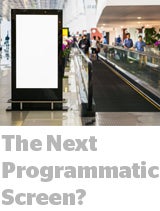 Verizon Media, the telco giant’s ad tech and content unit, added digital out-of-home (DOOH) supply to its SSP on Tuesday.
Verizon Media, the telco giant’s ad tech and content unit, added digital out-of-home (DOOH) supply to its SSP on Tuesday.
The SSP launch completes Verizon’s full-stack DOOH offering, having launched a DSP solution for outdoor media buys earlier this year. Verizon also has a network called Verizon Digital Signage, a collection of 3,000 interactive screens either owned by the company or that use Verizon to serve dynamic ads.
“When you have the whole stack, you can serve the whole market better,” said Iván Markman, Verizon Media’s chief business officer. He said the consolidated DOOH product allows advertisers and publishers to simultaneously integrate with Verizon’s data services, like location targeting or attribution, and to connect buyers who otherwise wouldn’t know about or be interested in DOOH supply.
Being able to uniquely package DOOH media for certain advertisers is also important because Verizon Digital Signage’s network is only in places where interactive screens have been set up, like transit hubs, shopping malls and gyms.
DOOH opportunities are often niche. One of the Verizon Digital Signage’s public supply partnerships is with retired golfer Greg Norman’s company Shark Experience, to serve ads to screens in golf carts.
The inventory is all digital, dynamic and served in real time (so none of it is static OOH signs or billboards). And Markman said the format is typically display placements, not video ads.
The inventory rates can vary as much as they do for display campaigns across sites or apps, he said. “But in general the CPMs are attractive to publishers.”
Although the DOOH solution is integrated with Verizon’s programmatic stack, it isn’t exactly one-to-one marketing, like buyers can do when they target someone’s phone or browser.
But there are targeting and segmentation capabilities, Markman said. With Verizon’s and third-party location data, for instance, the company can map to nearby mobile devices, so brands could still identify places trafficked by a target audience like “young women,” or even specific audiences based on a device ID.
The Verizon DOOH DSP and Verizon Digital Signage are primarily used by omnichannel advertisers, he said, and rarely for channel-specific OOH campaigns. For example, he said General Mills’ Wheaties brand used the Verizon DOOH service as part of its full-funnel effort to reach a certain segment across channels, including social, mobile native and video.
The OOH category is seeing a significant boost from digital signage and programmatic integrations. Outdoor media is growing about 8% year-over-year and is the only traditional channel that isn’t flat or decreasing, according to GroupM’s US ad forecast released last week.
The OOH market is small compared to digital media or other channels like radio and even print, but Markman said even in 2019 there’s been a big surge of interest in dynamic screens and signs.
“It’s still just emerging but already a relevant category,” Markman said. “And when we think of our customers it’s a category they’re demanding as a course of innovation.”













